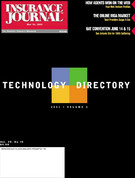Electronic communications between agents and carriers have received much attention over the years, as the struggle goes on for better technology, single entry of data and lower-cost delivery.
But what if you’re a key player along the way between 200 agencies in 20 states and 10 carriers? Where would technology fit in? And wouldn’t you be faced with an even greater morass of double or triple entry of information and incompatible communications methods?
Managing general agents do have those issues. And while there is no perfect solution now to complete the business cycle from retailer to MGA to carrier and back again, a vibrant and eager group of agency technology providers is aiming to make it better. And MGAs who are using the latest technology are going to be able to grow rapidly—and are setting the pace for how even very basic personal and small commercial lines will be written, sources agree.
Over the years, many MGAs built home-grown, DOS-based propriety technology systems, as they saw no other option in the marketplace or they figured they could save some money and get precisely what they wanted. Who can blame them? MGAs face more unique technology challenges than agents. But agency technology providers are responding with modern solutions that utilize the Internet, Windows, and extensible markup language (XML) in an ASP environment for data that all translates to real-time communications with multiple trading partners—agents, carriers, information providers and others.
“For a number of years we saw the MGAs develop their own very specific proprietary systems, and hire their own IT people and have them on staff,” said Jane Hassel, vice president, business partner development for Applied Systems. “Proprietary has one advantage in that it does exactly what they want a program to do in a particular feature set. But the difficulty is you never have the time to fully develop the specific feature set.”
For example, she noted, while a complete general ledger is built into the Applied System, one MGA had 350 separate and proprietary program models for rating, billing, follow-up, binder, issuance, etc. And not all were integrated, meaning dual entry for the MGA.
Timothy Hardine, senior vice president of XDimensional Technologies Inc., said many MGA technology systems still are stuck in a DOS platform. “It will be increasingly hard for systems to stay competitive if they have not made the leap to Windows.” He added that all software vendors would eventually offer their products in an ASP environment “to reduce costs for agencies and to bring new tools to market that leverage the power of the Internet.”
Popular features
So what are the specific features MGAs look for in management systems? Clearly, the Holy Grail for them would be complete integration of workflow among retailer, MGA and carrier. But that’s not available now for most MGAs—particularly larger, multi-state firms—said Clyde Owen, president of Insurity Solutions Inc., which was recently purchased by a ChoicePoint subsidiary.
Bart Koch with Tejas American General Agency (TAGA) in Austin, agreed. One of his frustrations is the inability to fully interact electronically with his 400 agencies.
Koch said important features for him include an integrated general ledger, an efficient insurance accounting piece, reports, workflow management and claims. An MGA and surplus lines broker, TAGA handles more than $23 million in workers’ comp and ranch premium mainly in Texas. Other features that hang off his Policy Master system include claims management, premium finance, policy issuance and workflow tracking.
XDimensional’s Hardine said MGAs ask for submission clearance and tracking; system support for the retail agency relationship; policy rating, quoting and issuance; GA/MGA/wholesale broker-specific accounting functionality; and standard and ad-hoc reporting functionality. “Because we offer our software in an ASP environment and have other Web-architected products, we have middleware that enables a retail agency to generate information out of their system via their standard reporting engine, which can then be captured by our Web-based middleware piece. This in turn is integrated with our product and can populate this GA system with the appropriate information. This greatly reduces the friction of that information transfer.”
Systems should offer flexibility in implementation and integration with other systems, particularly since MGAs often change products, markets, companies and retailers, sources said. For example, MGAs should be able to work within their software to create their own underwriting filters to differentiate between classes of business and agents, according to Insurity’s Owen. Easy maintenance also is a plus. “MGAs should be doing some of the populating of content in the database” to keep programming costs at a minimum, Owen said.
“The first three things every GA needs is rate, quote and issue,” said Applied’s Hassel. “If you get beyond those items, they are looking for single entry. Most MGAs I see enter data three, four and up to five times. With single entry, the retailer enters the data. Or even their customers enter the data.”
If the retail agent and the MGA both have Applied technology, Hassel noted, they can communicate in real time. The MGA’s system treats the retailer as a company would treat an agent, and when it’s time for the wholesaler to communicate with the company, that also can happen in real time. The Applied system works particularly well for agents who wear two hats as agents and MGAs, she said.
Hassel said a remote connection to the MGA database is also a critical feature, especially in light of mergers and acquisitions among agents and brokers that result in more office locations.
In Owen’s view, “With the typical MGA, the place to start is the basic 80/20 rule. What makes the most sense is to automate the mission-critical features for your business. And for an MGA that means rating, policy issuance and customer service.”
Some technology vendors can also offer claims tracking, real-time data views, rating software, timeline and reporting modules, accounting, integrated e-mail, and desktop faxing.
Get out the checkbook
MGA technology certainly isn’t cheap, and whether it’s homegrown or store-bought, there is no perfect solution. Upfront costs for smaller systems typically range from $20,000 to $50,000, depending on the size of the firm and the customization required. There are one-time and/or ongoing per-user setup and licensing fees, training costs, and data conversion and customization charges.
But MGAs requiring expansive systems for agency management, submission, customer relationship management, rating, policy issuance, claims, loss and safety, managed care, and audit might have to spend between at least $100,000 and as much as a half-million dollars, depending on the level of functionality, number of states and users, and the hardware required, sources said.
What’s the fastest-growing MGA customer sector for the technology providers? XDimensional’s Hardine sees growth with “wholesalers who are establishing themselves as program managers for specific niche market products. This is especially true of smaller wholesalers who excel in certain niches from both a knowledge and service perspective. In order to stay alive, they need to maintain their advantage and grow in their area of expertise.”
Policy Master’s Bradley advises MGAs not to look for the cheapest deal, or try to home-grow the solution in pieces. “Doing it right the first time and taking advantage of it from a business perspective is a better way to go,” he said. “We find a lot of MGAs are making very good money and the last thing you want right now is to have the system holding you up.”
Hassel observes bright prospects for online MGAs such as AgentSecure and InsuranceNoodle, which are writing Main Street America risks. “A lot of smaller agents don’t have contracts with standard markets. I think that’s the largest growth area,” she said. “It’s not program business. It’s really expanding more traditional business, like BOP and personal lines.” These firms have excellent relationships with name-brand companies and carefully underwrite agents that otherwise can’t access the companies because of minimum premium volume requirements.
These MGAs “are opening up their geographic area coast to coast because of the Internet,” Hassel said. “They can touch agents in every state—they’re not as regional as they used to be.”
Standard line MGAs are “a very significant move in the marketplace, and we’re seeing a lot of people that use us as the backend to build that business,” Bradley agreed. The fastest-growing MGAs are “not necessarily specialty radioactive-waste-hauler-type stuff,” he said.
Topics InsurTech Agencies Tech Insurance Wholesale
Was this article valuable?
Here are more articles you may enjoy.


 Florida Lawmakers Ready for Another Shot at Litigation Funding Limits
Florida Lawmakers Ready for Another Shot at Litigation Funding Limits  Florida Insurance Agency VP Sentenced to 3 Years in Massive ACA Fraud Scheme
Florida Insurance Agency VP Sentenced to 3 Years in Massive ACA Fraud Scheme  Wildfires, Storms Fuel 2025 Insured Losses of $108 Billion: Munich Re Report
Wildfires, Storms Fuel 2025 Insured Losses of $108 Billion: Munich Re Report  10 Highest Class-Action Settlements in 2025 Eclipsed $70B Total: Duane Morris
10 Highest Class-Action Settlements in 2025 Eclipsed $70B Total: Duane Morris 



